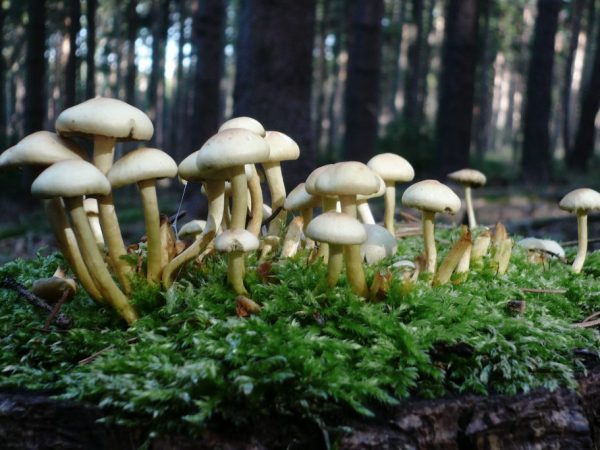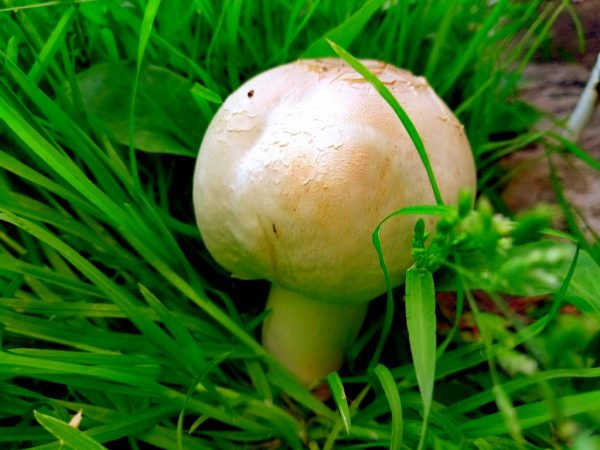Similarities and differences between champignon and pale toadstool
The similarity between the pale toadstool and the champignon leads to bad consequences for inattentive or beginner lovers of "quiet hunting". Going into the forest, you should carefully study edible mushrooms and their differences from poisonous ones.

Similarities and differences between champignon and pale toadstool
Differences
Comparison of pale toadstool and champignon is an important aspect in mushroom science.
The edible mushroom is characterized by small white fruiting bodies, and the grebe at different ages has a peculiar structure and smell. At first glance, representatives of these species are similar to each other.
Distinguish champignon and pale toadstool in several ways:
- Appearance.
- Smell, texture, change in the flesh at the break.
- Spread.
Toadstool poisoning is one of the most dangerous. Therefore, when collecting similar fruiting bodies, you need to carefully monitor all the specified parameters, note the minimum differences. If in doubt, it is better to leave the mushroom in the forest.
The champignon differs from the pale toadstool and a number of other signs:
- It is often wormy, insects sit on it. They avoid poisonous fruiting bodies.
- The flesh is dirty, of an irregular shade. Dangerous mushrooms are beautiful, practically have no external flaws.
There is a popular method for checking the safety of harvested mushrooms. The suspicious species is boiled together with a whole onion, only a white one is suitable. If it turns blue, you can't eat it. But the method does not give a 100% guarantee that this particular fruiting body is safe. You should not pick mushrooms nearby inedible specimens - there are spores on them that are dangerous for people with individual intolerance.
The people consider milk thistle broth as an antidote. But in case of poisoning, it is better to call a doctor and not self-medicate.
Description of mushrooms
Pale toadstool and champignon are extremely similar.
Description of the edible mushroom:
- fruiting body from 3 to 20 cm;
- the cap is round, convex, dense to the touch;
- the skin is pressed through with a fingernail, usually the dent is not restored;
- body color varies from white to brownish;
- frequent plates darken with age;
- the leg is even, loose and soft inside, sometimes 2 rings are present.

Edible and poisonous mushrooms are very similar
The species is used in the food industry. Antibiotics are obtained from it. There are also inedible representatives:
- redhead;
- flat-headed;
- false.
They are classified as conditionally edible, consumed after a long boiling. With insufficient processing, moderate poisoning occurs.
The poisonous twin looks like this:
- the fruiting body is ovoid, covered with a film;
- a hat up to 15 cm in the form of a flat dish with a slight bulge in the center;
- the stem is in the form of a cylinder, at the base there is a noticeable tuberous thickening;
- the plates are white, free.
Severe poisoning is already caused by 30 g of the fungus. Heat treatment does not reduce the level of danger - the toxins of the fungus are resistant to prolonged exposure to high temperatures. The first signs of poisoning appear 6-24 hours after eating.
Irina Selyutina (Biologist):
While many are accustomed to "disinfecting" the body in case of infection or other problem, the situation is completely different in the case of pale toadstool. In case of poisoning with this mushroom, in no case should you use alcoholic beverages to "disinfect" the internal organs. Alcohol not only will not destroy toxins, but vice versa, will help them penetrate the bloodstream even faster and spread throughout the body, which can accelerate irreversible processes.
External similarities and comparison of toadstool and champignon:
- In the edible species, the plates are colored (with the exception of young individuals). In a dangerous specimen, they remain white or cream throughout their life.
- The pale toadstool has a characteristic filmy ring at the bottom of the leg - a volva. It is necessary to cut any species to the very base in order to detect features that say that we have an inedible mushroom in front of us. The champignon has 1 or 2 rings under the cap; in young individuals they are fused with it.
- The main difference is that the poisonous mushroom has a distinct tuberous thickening at the base of the leg. Edibles do not have it.
Smell and structure of the pulp
Differences between pale toadstool and champignon are determined by smell and structure. The edible specimen has a weak smell. It is called almond or aniseed. Medium density pulp, uniform color. A fracture in air becomes yellow or reddish in forest species, and slightly darkens in ordinary whites.
Pale toadstool has a peculiar taste and smell. Young individuals are characterized by a light sweetish aroma, old ones - sugary. Despite the sweetness, it is unpleasant. Sometimes specimens are odorless at all. Surviving victims note the pleasant taste of the pulp. The flesh on the break is white or creamy.
Distribution locations
The species grow in the same places:
- Champignon prefers moist, humus-rich soil. Different species choose forest and meadow humus, bark of dead trees, anthills, tall grass, desert and steppe (more often in Europe). It begins to grow in late spring, some species bear fruit until late autumn.
- Toadstool loves deciduous trees and bushes - beech, hazel, oak. It happens in mixed forests. Fruiting from late summer to late autumn.
To avoid danger, it is worth picking ripe edible fruits that already have distinctive features.
Conclusion
The similarity of dangerous and safe specimens can lead to poisoning. But there are fundamental differences in appearance and structure. They also pay attention to the world around them - edible fruits near factories and roads are unsafe.



